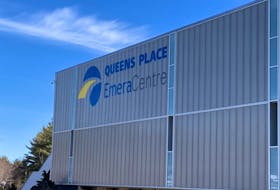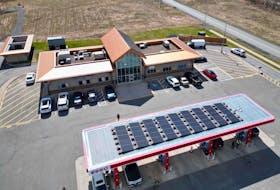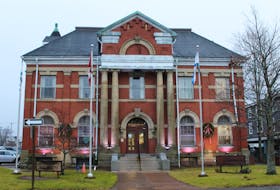The divestiture of the harbour is a key piece in moving ahead with port development, municipal officials have said on a number of occasions.
Now, despite being told by the federal government that it “satisfied” the consultation requirements with First Nations, CBRM Mayor Cecil Clarke said the municipality found out only recently the divestiture of the harbour has been complicated by an aboriginal claim to the harbour and much of the land surrounding the harbour including the property where the former Royal Cape Breton Yacht Club once stood.
The Kwilmu’kw Maw-klusuaqn also known as the Mi’kmaq Rights Initiative, works with 12 aboriginal bands in Nova Scotia to implement treaty rights, and works in close negotiation with the Nova Scotia government.
Membertou Chief Terry Paul, the Mi’kmaq Rights Initiative co-chair, said talks hadn’t concluded between his organization and Transport Canada on the harbour divestiture issue.
“There is no signed agreement as per the requirement for consultation under the Mi’kmaq-Nova Scotia-Canada terms of reference,” Paul said in a telephone interview from Ottawa, Tuesday.
He said Membertou has no intention of impeding economic progress, but added a process must be followed.
The aboriginal community is looking to have “meaningful and significant Mi’kmaq involvement in the development of the harbour,” Paul said.
“We must be involved in the planning, development and management of the harbour bottom.”
During a special council meeting Tuesday, Clarke said he met with Paul last week to clarify the Mi’kmaq Rights Initiative’s position. He also spoke with Eskasoni Chief Leroy Denny by telephone.
Clarke said First Nations are looking to be “more engaged” in the divestiture process. However, the extent of aboriginal participation wasn’t clearly defined, the mayor added.
During debate on the issue councillors mentioned several infrastructure projects undertaken by Membertou, which received co-operation from the CBRM.
A timeline listing those initiatives dating back to 2005 was given to reporters present at the meeting.
“We’ve proven, as indicated by council, on priorities of our First Nations we’ve worked earnestly to help them grow as we want to grow, and I would have thought the same would be reciprocal on our priorities as a community as well,” Clarke said.
Another issue of some frustration to the mayor is a letter Premier Stephen McNeil sent to Transport Minister Lisa Raitt a week ago.
In it, McNeil expressed his concern the federal government “properly conduct consultation and engagement” with the Membertou and Eskasoni First Nations communities with respect to the divestiture of the harbour.
The premier also asked Raitt to “strongly consider” a formal role and representation for the aboriginal communities in the makeup of the port’s governing body.
Clarke said he questioned why the province would add “another layer of confusion” by getting involved in the process.
The Nova Scotia government stepped away from its interest in the harbour bed back in May, allowing the CBRM to continue its pursuit of ownership.
Despite this setback, CBRM lawyer Jim Gogan said Transport Canada still wants to see a deal finalized.
“As of only two hours ago, we were told the process is ongoing and they reiterated that Transport Canada is absolutely committed to continuing with this process.”
The aboriginal title claim is an “overarching issue” so it must be dealt with before moving on with negotiations, said Gogan.
There are only “a few” outstanding issues left to be resolved, he said, including who’s responsible for spills and pollution in the harbour.
To date, Transport Canada has divested or otherwise transferred 180 regional and local ports that it owned until the late 1990s, with 60 ports remaining under federal ownership.
Divestiture of Sydney harbour is needed to allow access to water lots near the Sydport Industrial Park. The CBRM bought the so-called greenfield site – reshaped land from dredged harbour sediment – for $6 million in 2012.
The municipality has been marketing the 500-acre property as the site for a future container terminal pier, however no investors have come forward more than two years on.
Confidentiality agreements keep municipal officials from discussing the interest some potential investors have in the port, Clarke has said.
The CBRM favours a lease agreement so the municipality itself can stay in control of the site.
Timeline of events in the divestiture process of Sydney harbour:
• Oct. 18, 2013: Cape Breton Regional Municipality, Enterprise Cape Breton Corp. officials meet with Transport Canada to request divestiture of Sydney harbour to CBRM.
• May 2: Nova Scotia government steps away from its interest in the harbour bed and gives notice pursuant to the federal directive on the sale and transfer of surplus real property, which requires Ottawa to give provincial governments the opportunity to acquire surplus lands in priority before municipal governments.
• July: Transport Canada informs CBRM that the aboriginal consultation was completed and the Sydney harbour divestiture negotiations will proceed.
• Aug. 12: CBRM council is informed that the required federal consultations with First Nations representatives have been successfully completed and the negotiations are proceeding.
• Aug. 27: The Mi’kmaq Rights Initiative sends a letter to Transport Canada asserting an aboriginal title claim to Sydney harbour. A letter is also sent to Public Works and Government Services Canada asserting a claim to properties to be transferred to CBRM from ECBC. The Mi’kmaq Rights Initiative acknowledges consultations have already occurred.
• Sept. 29: Clarke and CBRM officials meet with Chief Terry Paul to seek clarification on the Mi’kmaq Rights Initiative letter.
Source: Cape Breton Regional Municipality
The divestiture of the harbour is a key piece in moving ahead with port development, municipal officials have said on a number of occasions.
Now, despite being told by the federal government that it “satisfied” the consultation requirements with First Nations, CBRM Mayor Cecil Clarke said the municipality found out only recently the divestiture of the harbour has been complicated by an aboriginal claim to the harbour and much of the land surrounding the harbour including the property where the former Royal Cape Breton Yacht Club once stood.
The Kwilmu’kw Maw-klusuaqn also known as the Mi’kmaq Rights Initiative, works with 12 aboriginal bands in Nova Scotia to implement treaty rights, and works in close negotiation with the Nova Scotia government.
Membertou Chief Terry Paul, the Mi’kmaq Rights Initiative co-chair, said talks hadn’t concluded between his organization and Transport Canada on the harbour divestiture issue.
“There is no signed agreement as per the requirement for consultation under the Mi’kmaq-Nova Scotia-Canada terms of reference,” Paul said in a telephone interview from Ottawa, Tuesday.
He said Membertou has no intention of impeding economic progress, but added a process must be followed.
The aboriginal community is looking to have “meaningful and significant Mi’kmaq involvement in the development of the harbour,” Paul said.
“We must be involved in the planning, development and management of the harbour bottom.”
During a special council meeting Tuesday, Clarke said he met with Paul last week to clarify the Mi’kmaq Rights Initiative’s position. He also spoke with Eskasoni Chief Leroy Denny by telephone.
Clarke said First Nations are looking to be “more engaged” in the divestiture process. However, the extent of aboriginal participation wasn’t clearly defined, the mayor added.
During debate on the issue councillors mentioned several infrastructure projects undertaken by Membertou, which received co-operation from the CBRM.
A timeline listing those initiatives dating back to 2005 was given to reporters present at the meeting.
“We’ve proven, as indicated by council, on priorities of our First Nations we’ve worked earnestly to help them grow as we want to grow, and I would have thought the same would be reciprocal on our priorities as a community as well,” Clarke said.
Another issue of some frustration to the mayor is a letter Premier Stephen McNeil sent to Transport Minister Lisa Raitt a week ago.
In it, McNeil expressed his concern the federal government “properly conduct consultation and engagement” with the Membertou and Eskasoni First Nations communities with respect to the divestiture of the harbour.
The premier also asked Raitt to “strongly consider” a formal role and representation for the aboriginal communities in the makeup of the port’s governing body.
Clarke said he questioned why the province would add “another layer of confusion” by getting involved in the process.
The Nova Scotia government stepped away from its interest in the harbour bed back in May, allowing the CBRM to continue its pursuit of ownership.
Despite this setback, CBRM lawyer Jim Gogan said Transport Canada still wants to see a deal finalized.
“As of only two hours ago, we were told the process is ongoing and they reiterated that Transport Canada is absolutely committed to continuing with this process.”
The aboriginal title claim is an “overarching issue” so it must be dealt with before moving on with negotiations, said Gogan.
There are only “a few” outstanding issues left to be resolved, he said, including who’s responsible for spills and pollution in the harbour.
To date, Transport Canada has divested or otherwise transferred 180 regional and local ports that it owned until the late 1990s, with 60 ports remaining under federal ownership.
Divestiture of Sydney harbour is needed to allow access to water lots near the Sydport Industrial Park. The CBRM bought the so-called greenfield site – reshaped land from dredged harbour sediment – for $6 million in 2012.
The municipality has been marketing the 500-acre property as the site for a future container terminal pier, however no investors have come forward more than two years on.
Confidentiality agreements keep municipal officials from discussing the interest some potential investors have in the port, Clarke has said.
The CBRM favours a lease agreement so the municipality itself can stay in control of the site.
Timeline of events in the divestiture process of Sydney harbour:
• Oct. 18, 2013: Cape Breton Regional Municipality, Enterprise Cape Breton Corp. officials meet with Transport Canada to request divestiture of Sydney harbour to CBRM.
• May 2: Nova Scotia government steps away from its interest in the harbour bed and gives notice pursuant to the federal directive on the sale and transfer of surplus real property, which requires Ottawa to give provincial governments the opportunity to acquire surplus lands in priority before municipal governments.
• July: Transport Canada informs CBRM that the aboriginal consultation was completed and the Sydney harbour divestiture negotiations will proceed.
• Aug. 12: CBRM council is informed that the required federal consultations with First Nations representatives have been successfully completed and the negotiations are proceeding.
• Aug. 27: The Mi’kmaq Rights Initiative sends a letter to Transport Canada asserting an aboriginal title claim to Sydney harbour. A letter is also sent to Public Works and Government Services Canada asserting a claim to properties to be transferred to CBRM from ECBC. The Mi’kmaq Rights Initiative acknowledges consultations have already occurred.
• Sept. 29: Clarke and CBRM officials meet with Chief Terry Paul to seek clarification on the Mi’kmaq Rights Initiative letter.
Source: Cape Breton Regional Municipality








